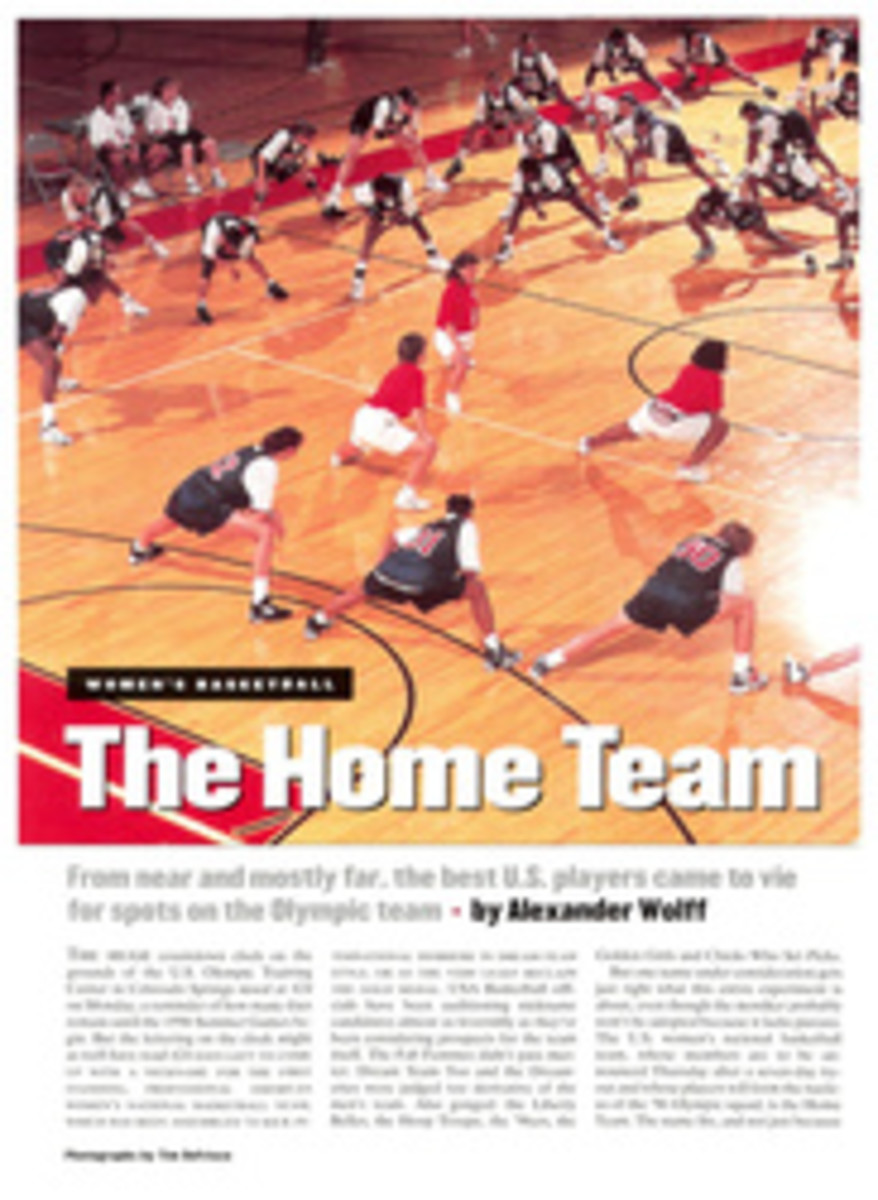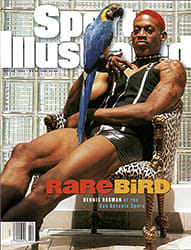
BARD OF THE LINKS IN THE DELIGHTFUL STORIES OF P.G. WODEHOUSE, ONE OVER BOGEY IS BLISS
It was a morning when all nature shouted, 'Fore!' The breeze, as
it blew gently up from the valley, seemed to bring a message of
hope and cheer, whispering of chip-shots holed and brassies
landing squarely on the meat. The fairway, as yet unscarred by
the irons of a hundred dubs, smiled greenly up at the azure sky;
and the sun, peeping above the trees, looked like a giant
golf-ball perfectly lofted by the mashie of some unseen god and
about to drop dead by the pin of the eighteenth. It was the day
of the opening of the course....
P.G. Wodehouse,
The Heart of a Goof, 1926
Before we proceed, it should be noted that a brassie is--or,
rather, was--a two-wood. A mashie was a middle iron. A goof was,
and perhaps still is, "one of those unfortunate beings who have
allowed this noblest of sports to get too great a grip upon
them, who have permitted it to eat into their souls." This
knowledge is derived from the researches of Sir Pelham Grenville
(Plummie) Wodehouse, who should have known.
If Harvey Penick was golf's Socrates--the game's greatest teacher
and philosopher--then Wodehouse was golf's Shakespeare: its
master comedian and tragedian, its bard. Wodehouse was also, in
the last three decades of his extraordinarily productive life,
the bard of Remsenburg, N.Y., a sleep-seeking village that lies
a five-iron from Shinnecock Hills, on the belly of Long Island.
Since the attention of the golf world will turn to that
neighborhood in June for the U.S. Open, this is a suitable time
to revisit Wodehouse's world of golf, an arcadia where bliss is
going 'round in one-over-bogey and where true love always
triumphs over a stiff wind.
Golf and love: Those are the two essential ingredients in the
golf stories of P.G. Wodehouse. (His canon is so overlarge that
it is divided and subdivided. There are the Jeeves novels, the
Blandings novels, the Psmith novels, the Jeeves stories, the
Mulliner stories, the school stories, the golf stories. Then
there's the miscellany.)
In the golf stories we have golf and love, love and golf. To wit:
You know how it is. If you have a broken heart, it's bound to
give you a twinge now and then, and if this happens when you are
starting your down swing you neglect to let the clubhead lead.
--There's Always Golf, 1937
"You love her?"
"Madly.
"And how do you think it affects your game?"
"I've started shanking a bit."
The Oldest Member nodded. "I'm sorry, but not surprised. Either
that or missing short putts is what generally happens on these
occasions. I doubt if golfers ought to fall in love. I have
known it cost men ten shots in a medal round."
--Scratch Man, 1959
And so (said the Oldest Member) we come back to our original
starting point--to wit, that, while there is nothing to be said
definitely against love, your golfer should be extremely careful
how he indulges in it. It may improve his game or it may not.
But, if he finds that there is any danger that it may not--if the
object of his affections is not the kind of girl who will listen
to him with cheerful sympathy through the long evening, while he
tells her, illustrating stance and grip and swing with the
kitchen poker, each detail of the day's round--then, I say
unhesitatingly, he had better leave it alone. Love has had a lot
of press-agenting from the oldest times; but there are higher,
nobler things than love. A woman is only a woman, but a hefty
drive is a slosh.
--A Woman Is Only a Woman, 1922
The golf stories could be called "the Oldest Member stories," as
all but a couple of them are narrated by this veranda-sitting,
tweed-suited gentleman who is possessed of "the eye of a man
who, as the poet says, has seen Golf steadily and seen it
whole." Routinely in these stories a young duffer will be
climbing toward the clubhouse from the 18th green, and the
Oldest Member will discern in his demeanor something that is
causing: 1) trouble in love, 2) trouble in golf or 3) trouble in
both. By way of remedy the Oldest Member will draw the youth
aside and relate "from the innumerable memories that rush to my
mind" a story whose moral sets things right. The stories are, if
you like this sort of thing, hilarious. At the very least, the
writing is always felicitous. "I read Wodehouse in my teens,"
says John Updike. "The golf stories seemed to me just as
wonderful as the rest, and to this day they seem the best
fiction ever done about the sport."
But why golf? What did the game mean to Wodehouse?
"Golf meant everything to him," says Peter Schwed, Wodehouse's
friend and longtime editor. "He was golf-mad."
Wodehouse was, as a boy growing up in late-19th-century England,
cricket-mad and rugby-mad. Frances Donaldson speculated in P.G.
Wodehouse: A Biography, that his background in sports served his
writing: "It was important to Plum's later career that he was
above average at games. In the school stories both games and
boxing are described with a practical knowledge, and an
enthusiasm which only personal participation and enjoyment could
give. And, although he took up golf too late in life to excel,
his theoretical knowledge is immense." Wodehouse, for his part,
implied with tongue in cheek that he wished he had spent more
time playing, less working: "Whenever you see me with a furrowed
brow you can be sure that what is on my mind is the thought that
if only I had taken up golf earlier and devoted my whole time to
it instead of fooling about writing stories and things, I might
have got my handicap down to under eighteen."
But he did spend his time fooling about writing stories. And
after the rejection-filled start that many writers encounter, he
became one of the world's most famous, most prolific and most
highly paid humorists. His vision of lunatic British men's
clubs, antic country castles and eternally sunny skies went down
like sweet vermouth during the Roaring Twenties. Not only was
Wodehouse entertaining, he was good. In 1939 Hilaire Belloc, the
essayist and critic, called him the greatest writer working in
English; fellow novelist Evelyn Waugh referred to him always as
"the Master."
The first golf story, The Clicking of Cuthbert, appeared in
1916. By then Wodehouse was playing the game, or at least
playing at it. "He never made any presumptions of being anything
but a duffer," says Schwed. Wodehouse had at least one good day,
and he wrote about it in the preface to The Golf Omnibus: "I may
have managed to get a few rays of sunshine into the stories
which follow. If so, this is due to the fact that while I was
writing them I won my first and only trophy, a striped umbrella
in a hotel tournament in Aiken, South Carolina, where, hitting
them squarely on the meat for once, I went through a field of
some of the fattest retired businessmen in America like a
devouring flame."
The Golf Omnibus, assembled in 1973, is the First Folio of
Wodehouse on golf: It is what you need, and it is all you need.
A collection of 31 stories, the omnibus includes several
classics: Goof, Cuthbert, Sundered Heart, Ordeal by Golf. In The
Coming of Gowf Wodehouse explains how the game first arrived in
the kingdom (the kingdom in question being Oom, where King
Merolchazzar eventually declares golf the official religion).
For all the silliness in the book, there is substance. "Two
things Wodehouse was very shrewd about were golf and
relationships," says Schwed. "He was an acute observer of the
species, and in the golf stories the satire is right on the
mark. Anyone who's ever golfed will have to laugh at the
situations out on the course. This stuff really happens, as a
golfer knows."
"No two of the matches he describes are alike," says Updike. "I
found them so delightful that when a few years later I had a
chance to take up the game I jumped at it. Wodehouse was my
first golfing experience."
The stories, then, aren't just for Wodehouse fans, they're for
golf fans--of which association Wodehouse was a dues-paying
member. "How I loved the game," he wrote in 1973. "I have
sometimes wondered if we of the canaille don't get more pleasure
out of it than the top-notchers. For an untouchable like myself
two perfect drives in a round would wipe out all memory of
sliced approach shots and foozled putts, whereas if Jack
Nicklaus does a sixty-four he goes home and thinks morosely that
if he had not just missed that eagle on the seventh, he would
have had a sixty-three."
Wodehouse was 92 years old when he wrote that. He had long since
given up the game; he rarely played after settling in
Remsenburg. It may seem surprising that the man who made the
world of Bertie Wooster's Drones Club famous never pressed for
membership in the National, Shinnecock Hills or any of the other
hallowed links of eastern Long Island. But the fact is,
Wodehouse harbored a lifelong loathing of clubs.
He spent his last days lamenting the direction that his beloved
game was taking. "Time like an ever-rolling stream bears its
sons away, and with them have gone the names of most of the golf
clubs so dear to me," he wrote months before his death in 1975.
"I believe one still drives with a driver nowadays, though at
any moment we may have to start calling it the Number One wood,
but where is the mashie now, where the cleek, the spoon and the
baffy?"
In Wodehouse, thank goodness.
COLOR ILLUSTRATION:ILLUSTRATIONS BY DAVID KLUG [man playing golf]
COLOR ILLUSTRATION:ILLUSTRATIONS BY DAVID KLUG [men playing golf]

